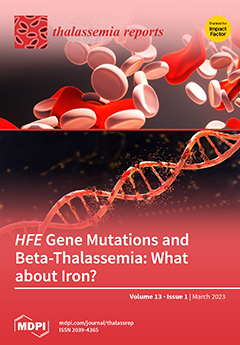The human hemochromatosis protein HFE is encoded by the
HFE gene and participates in iron regulation. The aim of this study was to detect the most frequent
HFE gene mutations in a control population and in β-thalassemia trait (BTT) carriers, and to study
[...] Read more.
The human hemochromatosis protein HFE is encoded by the
HFE gene and participates in iron regulation. The aim of this study was to detect the most frequent
HFE gene mutations in a control population and in β-thalassemia trait (BTT) carriers, and to study their relationship with iron metabolism. Total blood count, hemoglobin electrophoresis at alkaline pH, HbA
2 quantification, iron (Fe), total Fe binding capacity and ferritin were assayed.
HFE gene mutations were analyzed by real-time PCR. A total of 119 individuals (69 normal and 50 BTT) were examined. In the control group, 9% (6/69) presented a codon 282 heterozygous mutation (C282Y), and 19% a codon 63 mutation (H63D) (13/69, 11 heterozygotes and 2 homozygotes). In the BTT group, 3 carriers (6%) were heterozygous for C282Y, 14 (28%) for H63D, 1 (2%) for a codon 65 mutation and 1 (2%) was H63D and C282Y double heterozygous. Control group Fe metabolism did not show significant differences (
p > 0.05) according to whether or not they carried an
HFE gene mutation; while the BTT group with and without
HFE mutation showed higher Fe and ferritin than the control group (
p < 0.05). However, no increases in iron parameters were detected in BTT carriers that simultaneously exhibited an H63D mutation compared to BTT subjects without a mutation. Therefore, the iron metabolism alterations observed in BTT carriers could not be attributed to the presence of
HFE gene mutations. It is likely that BTT individuals have other genetic modifiers that affect their iron balance.
Full article




